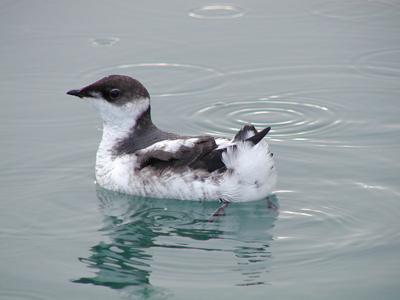Marbled Murrelet
 Description
Description
Marbled Murrelets are small seabirds. They are members of the same family as auks, puffins and murres. In winter, they have black and white plumage and conspicuous white wing patches. During the breeding season, they have mottled-brown plumage. Chicks have yellow or greyish yellow down, with dark spotted upperparts. Murrelets fly very quickly with rapidly beating, pointed wings.
Distribution and Population
Marbled Murrelets occur along 4 000 kilometers of coastline extending from California to Alaska. Within this range, they can be found up to 75 km inland. The geographic centre of the species’ range is in southeast Alaska, and Alaska and Canada are home to the largest numbers of birds. Populations in California, Oregon and Washington are fragmented. The winter range of the species is not well known, but in the southern parts of the range some birds may remain at breeding sites throughout the year. In Canada, Marbled Murrelets are found only in British Columbia. Here they occur in coastal areas in both summer and winter.
The Marbled Murrelet is very difficult to survey. The total population size is unknown, but it is estimated to be between 263 000 and 841 000 individuals, at least 50 000 of which occur in Canada. The status of the species in various areas is not well documented, but a preliminary estimate at one site indicates a 4% decline.
Habitat
Marbled Murrelets forage in the inshore marine environment, primarily in protected waters where both sand lance and surf smelt occur. They travel long distances between at-sea locations and nest sites. They require old-growth forest for their nests, which they place high in the trees. They need tree cover above the nest, but small gaps in the canopy for accessing the nest. The birds do not build nests, but use a large limb covered with deep moss that serves as a platform in which they make a depression for their single egg. In addition, in Alaska a very small percentage of birds nests on the ground. It is estimated that a large percentage of old-growth forests within this species’ range has been removed over the last 150 years.
Biology
Marbled Murrelets nest singly or in loose associations in inland areas. Their nests are very difficult to find and access, and the species is sensitive to disturbance. These factors make them very difficult to study. Their lifespan remains unknown, but the oldest Marbled Murrelet that has ever been found was more than 10 years old. Marbled Murrelet movements are not well understood either, but the birds carry out partial migrations outside the breeding season. The age at which they begin breeding is unknown but it is assumed to be about two years. Marbled Murrelets have a protracted breeding period, with the individuals of a population not all breeding at the same time. Both females and males share in incubating the eggs and caring for the young. Each pair has only one egg per season and incubation lasts about 28 days. Nesting success is low, mainly because of predation from other birds.
Threats
The greatest threat to Marbled Murrelets is thought to be loss of their nesting habitat. They have specific nesting needs in old-growth forests, which are the focus of much commercial activity. There are also substantial threats from oil contamination, and entanglement in gill-nets when the birds forage at sea. The species has a very low reproductive rate. Conservation is dependent on the species being long-lived and each pair producing many young over its lifetime. Human-induced factors threaten the survival of the adults, thereby putting the population at substantial risk.
 Deep Sea Crabs
Deep Sea Crabs